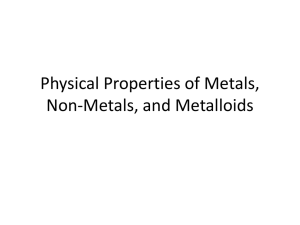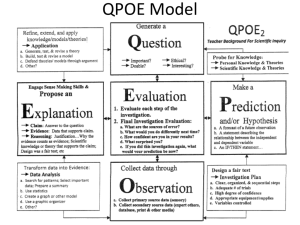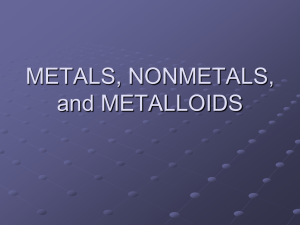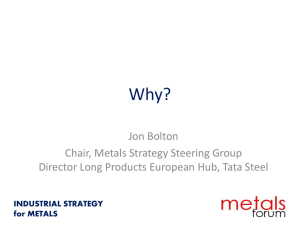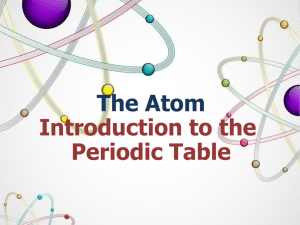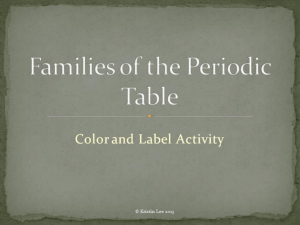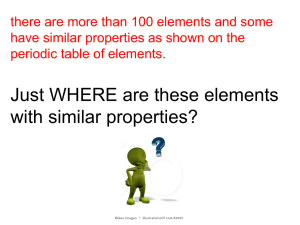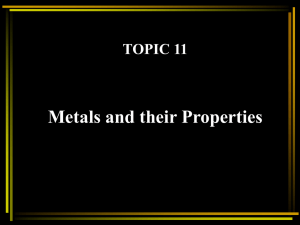Properties of the Elements
advertisement
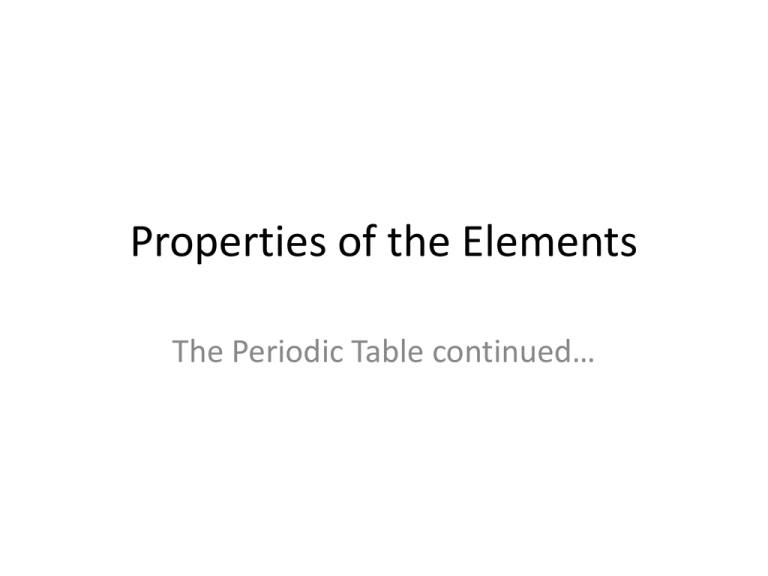
Properties of the Elements The Periodic Table continued… The Elements of the Periodic Table • Elements (matter composed of only ONE KIND OF ATOM) can be divided into THREE CLASSES based on their properties: –METAL –NON-METALS –METALLOIDS (Semi-Metals) METALS • Metals are a class of elements having these properties: • Luster (shiny surface) • Ductile (can be stretched into a thin wire) • Malleable ( can be hammered into thin sheets) • Good Conductors ( allow heat and electricity to flow through them) • Generally have 1 to 4 VALENCE ELECTRONS -(most have 1 or 2) Reactivity of Metals • Metals will react with other elements (usually non-metals) to form compounds. – The metals in Groups 1 and 2 are very reactive. – Group 1 and 2 metals are never found in their PURE FORM in nature…they are in compounds with other elements. • Pure Metals must be obtained by chemically separating compounds. Group 1 ALKALI METALS • The Group 1 Alkali Metals are very reactive with water: – Usually stored under kerosene or other oils to prevent contact with water. • ALKALI METALS VIDEO • Some common uses: • Lithium – batteries and medications • Sodium – in salts of many kinds and water regualtion in living things. • Potassium – in salts, also important for muscle function including the heart. Group 2 Alkaline Earth Metals • The Alkaline Earth Metals are also very reactive, though not as much so as Group 1. – Not found in PURE FORM in nature. – Pure Metal is obtained by chemically separating compounds. • • • • • Some common uses: Calcium – bones and salts Magnesium – salts and metabolism Barium – X-rays of the digestive system Radium – Radioactive – used in cancer treatment Groups 3-12 Transition Metals • The Transition Metals Group consists of 38 elements. • As with all metals, they ductile, malleable, and are conductors. • Many of these elements form very brightly colored compound with other elements and are used as paint pigments. • Three noteworthy elements are iron, cobalt, and nickel, these are the only elements known to produce a magnetic field. Some transition elements and their compounds used as pigments: Group 13 The Boron Family • The Boron Family consists of 5 elements. • Boron is considered a METALLOID while the rest are considered metals, though they are POOR CONDUCTORS. • Some important elements in the group: • Boron – used in detergents. • Aluminum – many uses. • Gallium – a silvery metal that will “melt in your hand!” Group 14 The Carbon Family • The Carbon group consists of 5 elements. • The group contains METALS, METALLOIDS and NONMETALS! • Some important members of the group: • Carbon – basis of life on earth (organic chemistry) • Silicon/Germanium– used to make computer chips. • Tin/Lead – metals known and used for centuries! – Lead can cause serious damage to the nervous system. Group 15 The Nitrogen Group • This group is made up of 5 elements. • This group also contains a NON-METAL, METALLOIDS and one METAL. • Some characteristics of the group: • Nitrogen – makes up about 78% of the air. • Phosphorus – used to make many products from matches, to soaps to plastics. • Arsenic – used to make poison! • Bismuth – used to make Pepto-Bismol! Group 16 The Oxygen Family • The group consists of 5 elements. • Contains NON-METALS, METALLOIDS and a METAL. • Some important elements: • Oxygen – needed for living things to carry on respiration (release of energy from glucose). • Sulfur – an important element in proteins. • Polonium – a rare radioactive metal. Group 17 The Halogen Family • • • • The group contains 5 NON-METALS. The name halogen means “salt-forming”. All THREE STATES OF MATTER are found in the family: Fluorine and Chlorine – gases • Fluorine – healthy teeth and refrigerants • Chlorine – disinfectant and table salt (sodium chloride) • Bromine – one of only 2 liquid elements (what is the other one??) - used as an industrial solvent. • Iodine - a solid element essential for proper THYROID function. Group 18 The Noble Gas Family • Contain 6 ODORLESS, COLORLESS gases that DO NOT REACT easily with other elements. • Common members of the family: • Helium – a carrier gas. • Neon – lights and medical lasers. • Radon – odorless, colorless, RADIOACTIVE gas. – 2nd leading cause of LUNG CANCER.

